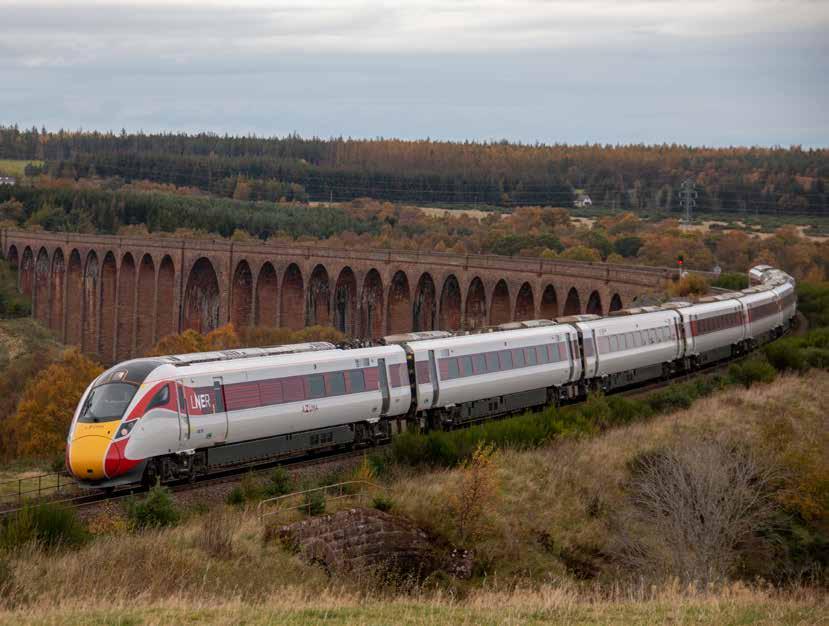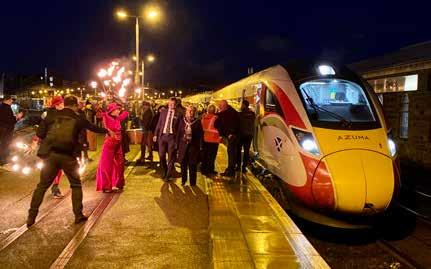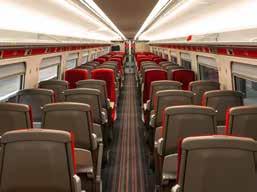
13 minute read
Azuma’s highest challenge
Azuma at Culloden on climb up to Slochd summit.
PHOTO: LNER - GRAEME ELGAR
The Highland main line (HML) between Inverness and Perth is the most severely graded line on the UK railway network. It requires southbound trains leaving Inverness at sea level to climb 1,315 feet in 22 miles to reach the Slochd summit - a maximum gradient of 1 in 60. After this, the line drops to 800 feet to go through the Upper Spey valley, overlooked by the Cairngorm mountain range. The line then climbs to the Druimuachdar summit (1,484 feet), the highest point on the UK network. Northbound trains climbing this summit face an 18-mile climb at a near constant 1 in 70 gradient.
Such gradients present a real challenge. In the early 1980s, the 10-coach Clansman train between Inverness and London Euston, hauled by a class 47 locomotive, topped Slochd summit at around 40 mph. The introduction of the Highland Chieftain service in 1984 from Kings Cross to Inverness

brought HSTs to the Highlands. With their two Class 43 power cars having a total power output of 3,356kW (4,500bhp), the HML’s summits were no longer such a problem. For example, a nine-coach HST has been recorded as climbing the 1 in 60 gradient to Slochd at 74mph and reaching the
summit 21 minutes and 48 seconds after leaving Inverness.
With ‘Azumas’ replacing HSTs on LNER’s Inverness to London service, Rail Engineer was keen to learn how the Hitachi-built class 800/1 bi-mode trains would tackle these gradients.
First Azuma from Inverness At 07:30 on the damp and dark morning of 10 December; there was a buzz at Inverness station as LNER staff, press, invited guests and ordinary passengers gathered around the podium erected to commemorate the inaugural Azuma Highland Chieftain service. LNER managing director David Horne noted that this train’s 580-mile journey to London was one of the longest in the UK. He explained the benefits of the Azuma, which included extra seats that are needed as this train carried 118,000 passengers a year to and from Inverness, a number that had doubled in the last 20 years.
Inverness provost Helen Carmichael welcomed the enhanced connectivity the new train would bring between London and the north of

Scotland and considered this to be an important day, both for the City and the Highlands.
After the speeches, the pipes and drums of the Pictish band Clanadonia, accompanied by whirling fire dancers escorted passengers to their train which was formed of unit 800 104 which carries LNER’s Scottish tartan. Now was the time to find out how the Azuma’s five 560kW generator sets would tackle the HML gradients. The train left 2½ minutes after its planned 07:55 departure due to a late incoming train on the single line to Inverness. Sitting above the under-floor diesel engine, I was aware of a slight hum as the train tackled its first 1 in 60 gradient. The Azuma is a particularly quiet and vibrationfree train - indeed, someone at the other end of the coach wasn’t aware that he was in a power car.
The log of the run is shown in table 1. My GPS indicated that the balance speed on the 1 in 60 gradients up to Slochd was 56mph. The summit was passed 23 minutes 46 seconds after leaving Inverness, two minutes longer than the time taken for an HST. The HML line speed is

generally 75/80 mph but has a 2.8-mile length of 90/100 mph level track between Aviemore and Kingussie, on which the Azuma accelerated from 71 to 96mph in 2 minutes 10 seconds before braking for Kingussie station. Soon afterwards, the train started its climb to Druimuachdar summit with a speed of 64mph up the 1 in 80 gradient.
Arrival in Perth was 5½ minutes late. Allowing for the late departure from Inverness and some slightly extended dwell times, the Azuma, which was running to HST timings, lost two minutes between Inverness and Perth. To allow for Azuma timings, the 15 December timetable changed the Highland Chieftain arrival time in Perth to be 1½ minutes later and reduced the station dwell time to give the same departure time.
South of Perth, there is a 1 in 100 climb to Gleneagles, which the Azuma managed at 84mph. 12 miles later, as it passed through Dunblane at 75mph, the train raised its pantograph to take power from the OLE and the gentle hum under my seat was no more.

(Above left) The drums of Clanadonia. (Above right) LNER managing director David Horne and Inverness provost Helen Carmichael lit up by the fire dancers prior to departure.
800 104 carrying LNER’s Scottish tartan.
arrive pass / depart arrive pass / depart pass point to point
0 Inverness 07:55 07:57:20
4.7 Culloden 08:031/2 08:05:23 55.7 35.0
22.4 Slochd 08:181/2 08:21:06 50.8 (1) 67.6
27.8 Carrbridge 08:231/2 08:26:01 60.7 65.9
34.5 Aviemore 08:29 08:31 08:32:43 08:35:10 60.0
46.3 Kinguissie 08:41 1/2 08:431/2 08:46:33 08:48:38 51.2
49.1 Newtonmore 08:461/2 08:51:55 72.2 51.2
59.3 Dalwhinnie 08:551/2 09:00:59 67.7 67.5
65.1 Druimuachdar Summit 09:06:28 64.4 63.5
82.6 Blair Atholl 09:15 09:20:48 55.5 73.3
89.5 Pitlochry 09:23 09:25 09:29:37 09:32:18 47.0
102.4 Dunkeld and Birnam 09:361/2 09:43:51 53.2 67.0
118 Perth 09:541/2 09:59 10:00:05 57.7
Running time less stops 01:53:30 01:55:32
Note: 1. 56 mph balance speed on 1 in 60, 50 mph PSR at Summit
Table 1: Log of the first class 800/1 passenger service between Inverness and Perth on 10.12.19.
Azuma Standard Class. LNER’s engineering director
On the train, it was good to chat to LNER’s engineering director, John Doughty, about the Azuma and its performance on the route. John conceded that it required two or three minutes longer than an HST on the Perth to Inverness route, though didn’t see that this presented any operational difficulties. He emphasised that the Azuma’s distributed traction gives it a more consistent operational performance than an HST, which can take much longer to climb the line’s long steep gradients when adhesion is poor. The train configuration is DPTS+MS+MS+TS+MS+TS+MC+MF+DPTF where DPT is a driving trailer with pantograph, M is a motor coach with generator set and traction motors and T is a trailer coach. The class of each coach is denoted by the letters S, F or C for standard, first or composite. Thus, of the Azuma’s nine coaches, five are power cars, each with four traction motors. Powered axles have sanders and are not at the train ends.
In contrast, the HST’s power cars at each end of the train each have four traction motors and no sanders.
John was asked whether, in view of the gradients on the line, the generator sets on LNER’s class 800 units should be upgraded from 560 to 720kW, as had been done on the GWR’s Class 800 units. He
Rail Engineer | Issue 181 | Jan/Feb 2020 advised that the GWR units needed upgraded engines as, due to curtailed electrification, they run long distances at high-speed, which requires extra power to boost the top end of the tractive effort curve. In contrast, all of LNER’s high-speed routes are electrified. For this reason, LNER does not consider that the cost of running upgraded engines, which would consume extra fuel and need more maintenance, can be justified.
In diesel mode, the Azuma may not quite have the power of an HST, but it offers other benefits. As all traction and auxiliary equipment is either under the floor or roof mounted, passengers can be carried almost throughout the length of the train. Furthermore, the Azuma has fewer, longer coaches (26 metres compared with the HST’s 23) and so has fewer vestibules. Both these features give the Azuma both 72 more seats than an HST and an extra seven centimetres leg room in standard class.


The Azuma’s seats have been criticised for being hard. Although they are certainly firmer, I did not find them uncomfortable. Clearly, seat comfort is a highly subjective matter and is perhaps influenced by an interior which is not as plush as the HSTs and IC225 trains that they replace, whose interiors were refurbished a few years ago. John advised that, following passenger feedback, additional luggage space is to be provided. This will be done by replacing some of the nonreservable windowless seats with floor-mounted racks.
John was also keen to stress the significant environmental benefits of the bi-mode Azumas, which eliminate diesel running under the wires. Previously, an HST on a London to Inverness train was diesel powered throughout its 580- mile journey, now the Azuma takes its power from the OLE for 435 miles, leaving just 145 miles diesel-powered. LNER is monitoring power consumption of the Azumas on the route to determine the precise carbon savings. For now, John estimates that, on the Inverness route, the Azuma’s carbon emissions are a third of an HST. LNER has plans for future emission reductions from its bimode Azumas as it is thought possible that they could be powered by batteries for short journeys beyond the OLE. For example, Lincoln and Harrogate would require roundtrips of 33 and 36.5 miles off the wire. To assess the feasibility of this concept, LNER is in discussions with Hitachi to replace, on one Azuma, one generator set with a battery pack charged by the OLE to evaluate its performance.
In another development, John mentions that agreement has now been reached with the regulator, the Office of Rail and Road (ORR), about a solution to the hazard of someone using the four sets of jumper cables between coaches as a ladder. This is to lengthen alternate sets of cables so that there are only two “rungs” spaced far apart.
The new fleet
At the start of 2019, LNER had 15 HSTs and 30 IC225 sets formed by class 91 locomotives and Mark 4 coaches. By the end of 2019, the HSTs had all gone and, by mid-2020, all the IC225 sets will have been replaced by Azumas. LNER will then have replaced its BR legacy fleet of 45 train sets with 65 Azumas comprising 23 bi-mode units

(13 nine-car class 800/1 and 10 five-car class 800/2) and 42 electric trains (30 nine-car class 801/2 and 12 five-car class 801/1).
At the time of the inaugural Inverness run on 10 December, the number of Azumas in service were as shown in the table 2.
LNER’s fleet of 15 HSTs, which were primarily used for services beyond its electrified network, were progressively withdrawn over the autumn as the Azumas were introduced on services London to Lincoln, Aberdeen, Inverness and Harrogate on 21 October, 25 November, 9 December and 15 December respectively. Prior to that, LNER introduced Azumas onto its Leeds services on 15 May and to Hull the following day. Azumas started to run from Edinburgh on 1 August, as reported in issue 177 (Aug/Sept 2019).
LNER’s last HST to carry farepaying passengers ran on 21 December. This was the last day of a special four-day tour by an HST that had been restored to its original BR livery to mark 41 years of service on the East Coast main line. Table 2: LNER Azuma programme.


(Above top) HST set with power cars 43296 and 43309 ready to leave Craigentinny depot for East Midlands Railway on 12.12.19. (Above bottom) Azuma on the Highland Chieftain approaching Haymarket. However, nine of LNER’s HST trainsets remain in service. They have been transferred to East Midlands Railway and are expected to remain in service until the end of 2020 when they will be replaced by cascaded Class 180 and 222 units, pending delivery of EMR’s own Hitachi bi-mode trains which are due to be delivered from 2022. The current plan for the introduction of LNER’s full Azuma fleet will see the last of LNER IC225 train sets replaced in June. Whilst it seems that there is no UK requirement for the displaced class 91 locomotives, some on the mark 4 coaches will be used on North Wales services and, probably, by open access operators. The iconic HST, introduced in 1976, and the class 91 electric locomotive, introduced in 1988, were both revolutionary designs which minimised unsprung mass and, in the case of the class 91, used research from the Advanced Passenger Train. The HST still holds the world speed record of 143 mph for a diesel train carrying passengers. From the late 1970s, it revolutionised British Rail Inter-City travel. However, both trains have now had their day as longdistance 125mph trains. Today’s railway requires 125mph trains, such as the Azumas, that carry more passengers with less carbon, even if they may be two-minutes slower going up Slochd summit!
Powering the Azumas
The rapid withdrawal of LNER’s HST fleet was made possible by the commissioning of Potteric Carr OLE feeder station, which feeds both Hitachi’s new Azuma depot at Doncaster and provides additional clean power for the East Coast main line. Prior to then, HSTs had to run through Doncaster as there was insufficient power for a full electric service. This 33kV intake into a This 25kV traction feeder station is fed from the local 33kV distribution network operator (DNO) network. It is the first in the UK for Network Rail to use a power electronics based ‘PCS 6000 Rail’ 50MW Static Frequency Converter (SFC), supplied by ABB Power Grids under a £14 million contract.
The Potteric Carr SFC feeder station was successfully commissioned into commercial operation by ABB on the ECML end of October 2019, following the completion of Network Rail product and system acceptance tests and the issuance of trial certification.
One key advantage of this technology is that it enables connection to the utility grid at lower voltages (compared to normal 132kV and above for the range of power required). It also potentially eliminates neutral sections on the railways and enables the power utility to see a ‘balanced’ supply into the railway power infrastructure. Based on an earlier engineering and option selection scheme by Network Rail, it is estimated that the chosen SFC solution, which eliminates the need for a costly high-voltage grid connection, reduces the cost of a new feeder station by 60 per cent. High-voltage grid connections were previously needed, as a single-phase 25kV OLE supply would otherwise result in an unacceptable phase imbalance in the grid supply.
This is not a problem with an SFC, which takes a three-phase supply, converts it to DC and then into a clean single phase 25kV supply for traction OLE and depot use. As a result, it is possible to take a three-phase balanced load from a local distribution network 33kV supply to power the single-phase 25kV OLE system.
Rail Engineer | Issue 181 | Jan/Feb 2020 ABB Power Grids has already installed SFC feeder stations in Brisbane and Queensland, Australia, as well as several other European countries.
SFCs were developed to interconnect power networks operating at incompatible frequencies. A typical example of this is a cruise ship, with a 60Hz on-board network that may have to be connected to a 50Hz shore supply. Other examples in the UK for 50Hz to 50Hz connection include interconnectors within the Western Power Distribution network area and the Maygen Renewable Generation project in Scotland.
Further power supply enhancements are required to maximise electric running on the ECML, and these are being delivered by phase two of Network Rail’s ECML power supply upgrade. This includes the commissioning of a new feeder station and 132kV connection at Hambleton Junction, near Selby, to provide resilience of supply, as well as two static frequency converter compounds at 132 kV supply points and the upgrade of the feeder station at Marshall Meadows, immediately south of the Scottish border.
It is the Marshall Meadows feeder station won’t be upgraded until at least 2021. Until then, some LNER services and all the new TransPennine Express services (30 trains a day) will have to operate on diesel power for the 64 miles between Longniddry and Chathill.

PHOTO: ABB










